How to adjust metal-plastic windows yourself. Other problems and their elimination. Horizontal adjustment of metal-plastic windows
There are many materials from which windows are made. One of the most popular is plastic. Plastic windows are durable, highly resistant to moisture, frost, temperature changes. However, in order to ensure the normal functioning of such a window, it should be adjusted. On the features of the pressure setting on the plastic window, we will consider further.
Plastic windows: the benefits of operation
Installing a plastic window is a fairly simple process, the quality of which depends on the correct observance of the technology for its implementation. In addition, such factors as the manufacturer, the materials from which it is made, fittings, profile, etc. are reflected in the quality of the window.
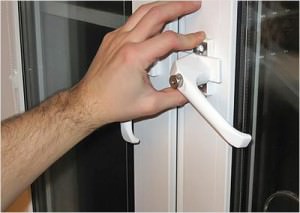
Among the advantages of plastic windows it should be noted:
- high level of protection of the living space from extraneous sounds;
- a high level of heat preservation in the room, the installation of one double-glazed window saves more than twenty percent of heat;
- good tightness eliminates drafts, so windows do not need additional paper pasting before winter;
- the duration of operation exceeds ten years, and if you follow certain rules for the use of these windows, they will last two or even three times longer;
- a high level of fire safety prevents burning or ignition of windows;
- aesthetic appeal - windows come in almost any color or shade, in addition, to clean them, it is enough to wipe them with a damp cloth;
- plastic windows do not require special care, they do not need to be periodically painted, unlike wooden ones;
- the versatility of the window is provided by such functions as the possibility of its ventilation, mosquito nets that protect the room from insects.
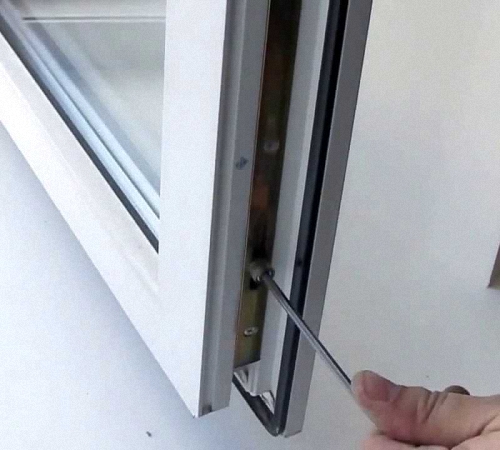
However, windows made of plastic have certain disadvantages, namely:
- Unlike wooden windows, they are not able to maintain the optimal temperature and humidity atmosphere in the room, thereby regulating it;
- periodically moving parts of the plastic window need to be lubricated, the channels cleaned and the seal replaced;
- in the warm season, the windows increase in size, and in the cold season they decrease;
- technologically incorrect installation of a plastic window significantly reduces its service life.
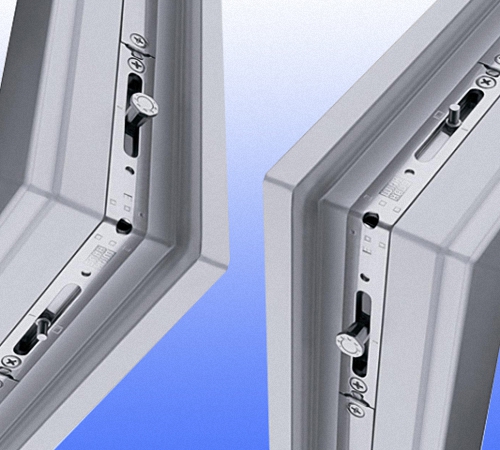
The device and design of plastic windows
Before studying the features of window pressure adjustment, you should familiarize yourself with the structural elements of a plastic window, among which are noted:
- frame;
- sashes;
- double-glazed windows;
- fittings;
- elements for sealing and sealing;
- glazing beads;
- shtulpy;
- impost.
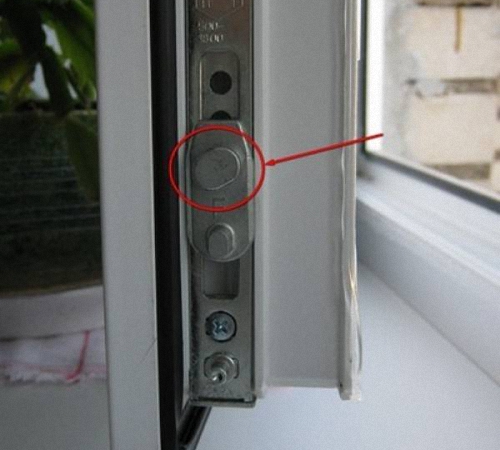
The frame consists of a profile on a plastic basis, inside of which there is a steel reinforcing reinforcement. The profile is interconnected by means of special welding. Its strength is very high and lends itself to special tests. In order to connect the steel profile with the plastic one, self-tapping screws are used. The frame must provide strength to the window and take on all sorts of loads.
Inside the doors there is also a steel profile. The main function of the sash is to ensure the normal closing and opening of the window during its operation. Accessories are called various kinds of elements made of steel, such as handles, awnings. The fittings provide ventilation of the window, its opening or closing. When choosing plastic windows, special attention should be paid to fittings, since the duration of operation of plastic windows also depends on its quality.
Double-glazed window is called an element that is able to transmit light into the room. There are windows with one, two, three or more double-glazed windows. Two glasses in a double-glazed window are able to form one air chamber. In order for the window to have good heat and sound insulation characteristics, a special gaseous substance is pumped inside the chamber instead of air. Beads are most often plastic, they hold the glass on the window.
In order to give the window additional tightness, an element in the form of a seal is used. With its help, moisture and cold air do not get inside the room. If the window consists of two or more structural elements, then an element in the form of an impost is installed between them. This part is made of galvanized steel reinforcing profile or plastic. The plastic version of the impost provides a complete release of the window opening. Steel elements are stationary and are fixed directly in the opening, dividing it into several parts.
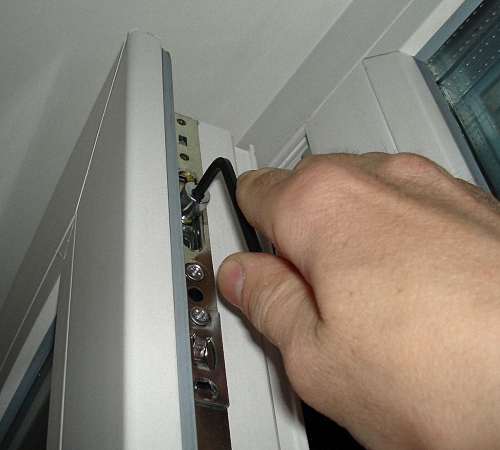
Adjusting the pressure of the plastic window and the features of its implementation
Adjustment of windows is required if during their operation problems of the following nature arise:
1. Drafts. If you are concerned about blowing windows, especially in strong winds, then you need to adjust the pressure of the plastic window.
2. The frame touches the lower part of the sash. In this case, sagging of the valves is relevant. In order to get rid of this problem, install vertical or horizontal sash adjusters.
3. In order to eliminate the problem of the handle becoming loose, it is enough to change the location of the plate that is inside it.
4. If there are difficulties with turning the handle, then it is necessary to change the location of the sash or lubricate the fittings in the window.
There are many options for plastic windows, which differ in quality, number of double-glazed windows, strength, etc. Each manufacturer has individual characteristics window settings.

The work of adjusting plastic windows is occupied by professionals, however, subject to certain rules, it is possible to do it yourself. In order to adjust the plastic window, in without fail you will need a four-millimeter hex wrench and instructions from the window manufacturer. If the nature of the breakdowns is associated with poor-quality installation of the window or its long-term operation, then they are completely eliminated with the help of additional adjustment or replacement of fittings.
There are several modes for adjusting plastic windows, the choice of one or another option depends on the nature of the malfunction. By adjusting the window in the horizontal direction, it is possible to get rid of a slight bevel or shift of the frame. For these purposes, it is necessary to gain access to the upper and lower hinges. They have holes for installing a hexagon. The window is adjustable in two positions, both horizontal and vertical. If the hexagon rotates clockwise, then the window is attracted to the sash, otherwise, it turns out to loosen the fastening between the window and the sash and lower its lower part.
Adjustment of the window on the upper hinge is performed only when the window is fully opened. Please note that in this case, it is impossible to move the window more than two millimeters.
In order to adjust the window in a vertical position, it is necessary to use the bottom hinged hinge. To do this, a special cap opens on the hinges, which allows you to open access to the hexagon hole.
If the hexagon is rotated clockwise, the sash will rise, otherwise, the sash will be lowered. The adjustment of the window is also possible by no more than two millimeters.

Technology for adjusting the pressure of plastic windows
Most often, most problems with plastic windows are eliminated by adjusting their pressure. By performing these actions, it is possible to get rid of drafts in the room and from heat losses in winter time of the year.
To check the need to adjust the sash pressure, it is necessary to bring a match to the window, if the flame is uneven or even goes out, then there is a need to adjust the sash.
In order to adjust the plastic window, use the eccentrics that are on the fittings. They are located behind the clamping parts of the handle. Their adjustment is quite quick and easy.
To tightly press the sash to the surface of the frame, turn this element clockwise. Turning the eccentric counterclockwise will loosen the leaf.
In addition, on the surface of the eccentric in most plastic windows there is a special pointer that helps to determine the quality of pressing the sash to the frame. If the pointer is closer to the seal, then the clamp should be pressed.
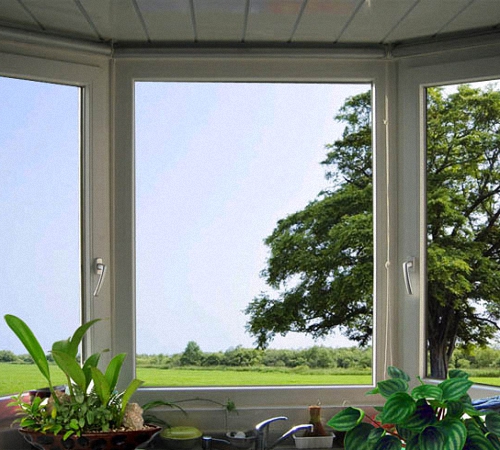
In relation to the quality and type of fittings on the window, pliers or special plates installed on the sashes are used to adjust the windows. Adjusting the window allows you to move it no more than one millimeter.
In addition, the adjustment of the pressure of the sashes is carried out seasonally. That is, in summer time year, when fresh air is needed in the room, the pressure is loosened, and in winter, to prevent heat loss, the pressure is increased. The operation of a window with a free clamp is more durable than with its strong sealing.
When the window is in the open position, it is fashionable to see the butt on it. This part is distinguished by the presence of three eccentrics or trunnions. With the help of a hexagon, the windows are periodically adjusted.
For more detailed instructions on adjusting certain windows, see the manufacturer's instructions for their operation. However, for most plastic windows, the principle of their adjustment remains unchanged.
In order to increase the pressure density, turn the hexagon to the left by two to three millimeters. This process is quite simple, but coordination should be observed during its implementation. That is, if the screw is too tight, the seal may be damaged. All eccentrics must be set in the same position, only in this case it will be possible to achieve uniform pressure on the entire window.
Please note, if the pressure adjustment is performed for the first time, then the adjustment should be minimal. At the end of the long service life of the window, this value should be increased. Since in the process of constant opening, closing the window, the rubber bands wear out and dry out.
If this is not done and the rubber band is pressed too hard, it will wear out in a couple of months and will have to be changed. In order to replace the old seal, it is enough to buy a new seal and install it, while adjusting the pressure. In no case should the seal be stretched too much, as over time it will begin to let air into the room.
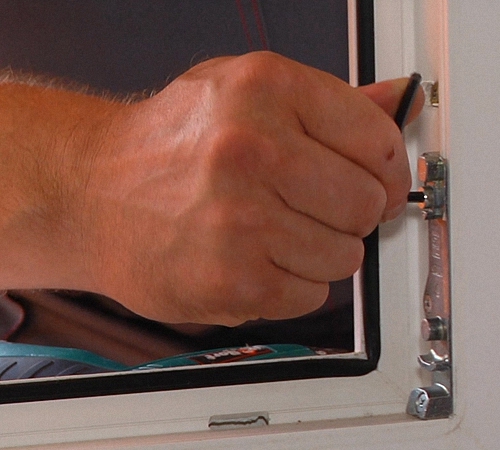
If there are problems with handle malfunctions on plastic windows, then it is enough to turn it at a right angle. Next, you should unscrew the fasteners that fix it on the window, turn the plates in the opposite direction and check the operation of the handle. If the problem could not be solved, then it is enough to unscrew the old handle and install a new one. It is advisable to choose fittings from the same manufacturer from which you bought the windows.
If the seal after adjusting the window pressure does not perform its functions, then there is a need to replace it. In this case, loosen the seal to the maximum value, remove it from the leaves and install a new one. Replacing the seal is relevant once every eight to ten years. This element of the window has excellent performance characteristics and is sufficiently resistant to wear. Provided that the window clamp is not pinched and the window is operated under standard conditions. If a creak occurs in the seal during the operation of the window, it is enough to lubricate it with engine oil.
If, after correcting the malfunctions on the plastic window, it was not possible to solve the problems, we recommend that you contact specialists who can quickly and efficiently repair plastic windows. It is much easier to fix problems at the initial stage of their formation than to change damaged parts or sashes.

An important factor long-term operation plastic window, are the conditions of its operation. Window fittings should be well adjusted. Do not wash the window with abrasive cleaning solutions and substances. In order to get rid of dirt on the window, it is enough to use a regular soap solution or water.
We are used to plastic windows. Those who installed them among the first know how many small malfunctions can happen. For various reasons, a Russian person does not always like to search for and call a master, skillfully understanding any mechanism on his own. In addition to minor repairs to the plastic window, over time it may be necessary to adjust the sash for a tighter fit. The main thing is to understand the principle of operation of the main plastic window settings and know where they are located. Do-it-yourself adjustment of plastic windows is quite simple, we will tell you what and where to turn.
What to prepare for a successful repair?
Basically, for a small repair, it takes no more than half an hour, and more often the process goes even faster. And of course, speaking “with their own hands”, everyone understands that some tools cannot be dispensed with. Stock up on a 4mm hex wrench (usually included in a bicycle repair kit), a Phillips screwdriver, a star-shaped nozzle and pliers. In addition to tools, WD-40 brand aerosol may be needed. Such a small set will allow you to adjust the plastic window with your own hands, including adjusting the windows according to the season.
At what points is it possible to adjust?
If you imagine an open window, then you can designate the inner corners (those that are adjacent to the frame) and the outer ones for each sash. Using such designations, it is possible to determine the adjustment points for plastic windows known to the masters.
The sash is horizontally adjusted in the region of the upper inner corner, as well as in the mechanism of the lower inner corner. Above the lower adjustment point (5-7 cm up) is the vertical alignment point of the sash.
The clamping of one sash can be strengthened / weakened at the nodes located along the outer edge: just above the outer lower corner and also just above the window handle.
This article discusses the general points for repairing the mechanism of plastic windows of any manufacturer. Adjustment for winter or summer, minor malfunctions - such problems are solved in almost the same way in all designs. The windows of different companies differ in small nuances - in such cases, the manufacturer's proprietary instructions will help.
How to repair plastic window handles yourself?
Over the years of operation, the handles of balconies, windows, doors lose their strength, become loose. You can often hear a complaint that the handle of a plastic window or door has suddenly jammed. These problems cannot be considered very serious, you need to learn how to tighten or change fasteners on your own. This is a simple operation.
The handle itself is adjacent to the pad, gently turning which, we get access to the adjusting unit. The overlay should be slightly pulled towards you and then rotated perpendicularly. Inside, two bolts made for a Phillips screwdriver will be visible. It may turn out that the decorative overlay will not be removed immediately. Try again carefully, it is better not to use sharp objects to avoid damage to the soft plastic.
Why install a handle lock?
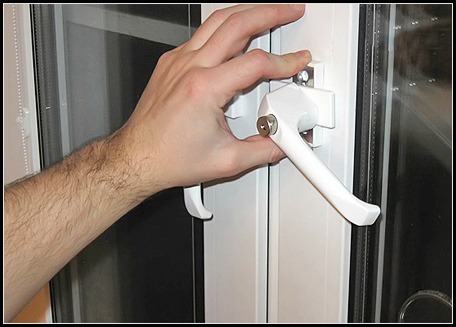
A special child lock on a plastic window was invented for the safety of babies. The handle, equipped with a lock, the baby will not open on its own. Although it would be useful to recall that there is no place for children on the windowsills at all. To change the handle, the old one must be removed in the same way as mentioned above, that is, you need to start with a decorative lining. Then both bolts are unscrewed, and the handle, slightly swinging, is carefully removed. The new handle is inserted in the same position and fixed with bolts. The operation will take 2-3 minutes.
Why does the handle sometimes stick, does not reach the maximum?
There are several reasons why the handle of a plastic window does not close, or vice versa, stops opening. First, over time, the mechanical assembly may become contaminated with dust. So, it's time to clean and lubricate it. You already know how to remove the handle. It is necessary to vacuum all the mechanisms of the handle and the mounting hole. Then the moving parts are lubricated with sewing machine oil. If it turns out that a rust coating has appeared, spraying with WD 40 will help.
Closing the handle with difficulty is a reason to try to debug the clamping of the valves. And the main rule: the handle is jammed - you can’t act by force, otherwise you won’t be able to restore the mechanism. Apparently, the locking mechanism, which operates in the open state, did not work in time. The lock lever must be adjusted by hand. In general, the lock lever on your window can be of two types: a metal tongue that, when opened, becomes at an angle to the window, or a clip that goes under the seal.
If the plastic window does not close in frost, it means that the blocker has decreased in size from the cold and does not reach its own response. The way out is to fix it in the desired position (adhesive tape will do if there is no time yet) and close the window. Later, you will have to put something under the answer, unscrewing it, or under the lever itself. The problem will disappear.
Do-it-yourself winter and summer adjustment of plastic windows
The window frame is designed so that the door fits snugly. The pressure is easily checked with a piece of paper. If the paper pressed by the sash is pulled through without difficulty, this is unacceptably weak pressure. Adjust at the points indicated above. The sash is set correctly if the leaf is torn or difficult to pull through.
Due to seasonal temperature changes, the sealing gum loses volume and density. This process does not happen quickly. After that, it is not always necessary to change the gum, it is enough to adjust the sashes with high quality. For this purpose, special mechanisms for adjusting the plastic window are tightened.
If you live in a region with regular temperature fluctuations, adjusting your windows correctly in winter and summer is very important. This reduces the extra load on the entire structure of the plastic window, on fittings, and also increases the life of the seal.
The pressure is adjusted by turning the trunnions (eccentrics) - oval cylinders at the end of the sash. On window frame you can see the grooves into which the hooks fall when the window handle is turned. By changing the position of the hooks, we adjust the pressure. If the oval is located vertically (option - with the flat side of the circle to the left), the clamp is weak. If you see a horizontal oval (the circle is turned flat to the right), the pressure is strong. The standard position of the trunnions is an oblique oval at a 45 degree angle (or the flat side of the i.S. trunnion circle is down). The fittings are turned by hand or pliers. Pins in the form of a circle with one flat side do not rotate around its axis, but have only working turns.
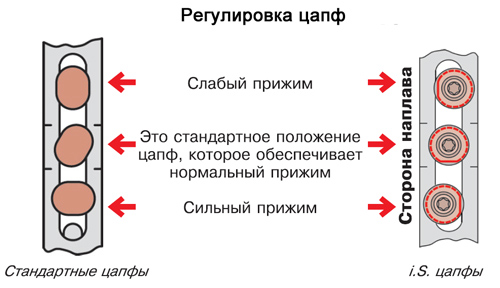
Watching a video on adjusting plastic windows helps some, it's easier to understand the process and evaluate your strengths. If it is not possible to debug the eccentrics, you need to tighten the reciprocal hooks located on the frame with a hex wrench. The way out will be to raise the answer a little, placing paper or a plate under it.
After the necessary adjustment of the pressure of the plastic window, we proceed to the adjustment from the side of the canopies. First, remove the plastic plug from the canopy. Under it are two hex bolts and another hidden bolt. The clamp is adjusted by a bolt located perpendicular to the window. Turn clockwise to increase pressure, counterclockwise to loosen. It is best to perform this operation when the window is closed.
The upper part of the sash is fixed with a mechanism - "scissors". Open the window, then press the spring lock on the end of the sash. Then turn the knob to ventilation mode. So the sash is removed from the upper hinge and begins to rest on the "scissors" and the canopy from below. The head will become visible, by adjusting which we can obtain the desired degree of pressure.
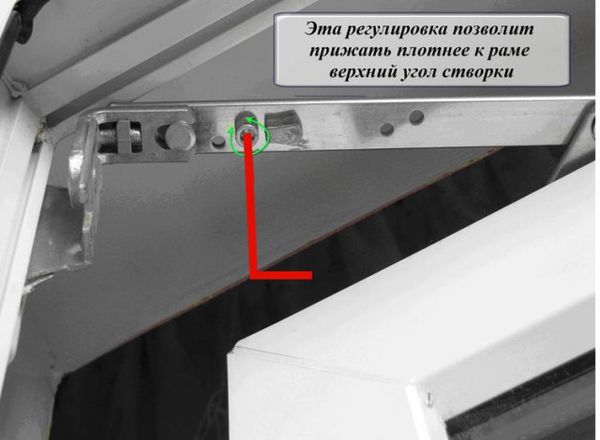
In this article, you can find out all their pros and cons.
The edge of the sash can touch the frame, and then the plastic window does not close
Maybe the window was not closed for a long time, or it was slammed sharply, and the holding mechanisms became loose. If there is no serious deformation of the components, it will help when you tighten the hinges of plastic windows.
Hexagon should adjust the bolts on the lower canopy and on the "scissors" at the top. Having removed the protective plug from the lower hinge, we will see a bolt with six faces in the upper part. You can lower the sash by turning the bolt counterclockwise. The reverse action lifts the sash.
Sometimes quite massive metal-plastic structures are ordered: large windows, doors with additional door closers. Their goal is to slightly raise the entire system before completely closing the plastic window. This mechanism is also being adjusted.
If suddenly the sash clings to the frame from the sides, another mechanism for adjusting the plastic window is used. This is a bolt at the bottom of the canopy, parallel to the window. It has two exits with key heads. That is, access to it is open from the side of the slope and from the side of the sash. The only access problem is that the slope may be too close. For this, there is a second way to access the adjustment. We turn the bolt clockwise - the sash moves to the right, counterclockwise - it moves to the left.
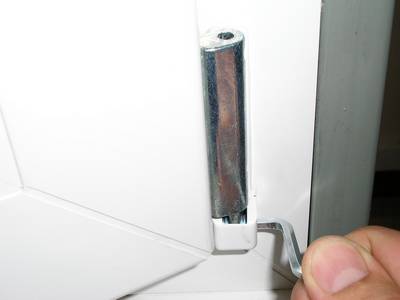
In another way, we adjust the position from above. We open the window completely, and on the side of the mechanism we look for a slightly recessed bolt head. By changing its position, we adjust the position of the sash at the top.
So, if a plastic window does not open, its handle jams, we see an incomplete fit of the sash, there are simple ways to adjust the loose mechanisms with our own hands.
These articles are usually viewed as well.
Any design a little more complicated than a stool has fastening zones and adjustments that become loose over time. In particular, anything can be the reason for the incorrect operation of PVC windows, at least the fact that the house shrinks, which means that the contours of all facade elements undergo minor changes. The result - the window does not close well, it blows from the gaps, the handle does not turn, and so on. In this case, it is necessary to adjust the plastic windows.
Of course, if the seal is worn out or the frame itself is deformed, adjustments will not help here, only repairs. But quite often the problem is solved with a hex wrench or pliers.
How to adjust the sash pressure
If it blows from under the seal, and the sash closes somehow, you need to adjust the pressure of the plastic window sash.
The sash pressure is regulated by eccentrics. Eccentrics are placed along the entire contour of the frame. When the handle is turned, the eccentrics go beyond their respective pressure pads. In order for the window to be pressed against the frame more tightly, the eccentric must be turned clockwise. To loosen the clamp - in the opposite direction.
Video "How to adjust the pressure of a plastic window sash for winter / summer":
There are risks on eccentrics. When the risk is directed outward, the clamp is loosened, towards the window seal it is tightened. Some eccentrics can be turned with a wrench or pliers, but more often a hex wrench is required for this purpose.
We eliminate distortions
Another option: the strikers on the frame are incorrectly adjusted. In this case, the PVC window does not close tightly, although the handle is turned all the way. Then you need to adjust the straps.
You need to open the window, slightly loosen the fasteners on the slats. Move them a few millimeters deeper. Tighten the screws, close the window. In two or three passes you will get the correct adjustment.
Video "How to adjust PVC window sashes yourself":
Another clamp is located on the side of the loops. It needs to be adjusted with a hexagon. Here you need to navigate by the tongue located on the sash: as you press, the tongue extends more. To push it out, the hexagon must be turned counterclockwise (for left-hand hinges). If the loops are on the right, then vice versa.
The clamp can and should be changed depending on the season. Tighten in winter and loosen in summer. Firstly, in the summer it makes sense to leave a small gap for natural ventilation, and secondly, for the sake of saving the seal (strong pressure contributes to early wear).
You can adjust the pressure of only the upper hinge or both, it depends on the fittings of the plastic window. To adjust the pressure on the lower hinge, you need to remove the cap from it and turn the bolt placed perpendicular to the double-glazed window.
The top hinge is adjustable at the flaps. To do this, open the window, switch it to the ventilation mode (in this case, someone must insure the window, because it will be held on one hinge). With this position of the window, it is easier to get to the hexagon, which regulates the pressure of the upper sash.







In the event that there is a blocker on the window (that is, the sash leans back only in the closed position), for tilting open window you need to simultaneously press the blocker and put the window into the ventilation mode.
How to adjust the glass yourself
The double-glazed window must be adjusted in the following cases:
- If sash sagged, and its bottom catches the frame. You need to lift the sash. You can try using the vertical or horizontal slider. You will probably have to try all the options, it depends on how loose the sash is. It is necessary to insert the hexagon into the hole in the window hinge and turn. Start from the top loop, further according to the situation. When adjusting the lower hinges, you need to remove the plastic caps.
- due to horizontal or vertical displacement the sash can cling to the frame middle part. It is necessary to move the sash with a double-glazed window to the side. For this, regulators are used, located in parallel with the double-glazed window. We start with the bottom loop, then move on to the top. In the course of adjustment, we control what has changed.
Other Issues and Troubleshooting
- If at closing handle doesn't turn well, sticks, the window does not lock at all, or it locks incorrectly (that is, before the handle is fully turned) - adjust the lock tongue. Try to turn the head of the eccentric bolt with a hex wrench and try to close the window again. Repeat again if necessary. Repeat until the window starts to close normally.
- If handle loose, the plate at its base must be rotated ninety degrees. You will see two screws. They need to be tightened and the plate returned to its place. If there is a need to replace the handle, remove the screws with a screwdriver, remove the handle and install a new one.
- If handle is hard to turn, you can try to lubricate all fittings (hinges, eccentrics, etc.) with machine oil. Sometimes it helps.
Such simple ways you can adjust the plastic windows yourself and do not have to call the master and give extra money.
Do-it-yourself adjustment of plastic windows is possible if:
- there was a draft from the window side;
- the sash rubs against the fittings or frame;
- in the open position, the handle jams and the window is blocked.
The reasons for these phenomena may be violations during the installation of the window structure, natural shrinkage of the structure, wear of rubber seals. In case of violations in the installation, you should call specialists. In other cases, the adjustment of plastic windows can be done independently.
In order to independently configure the fittings of plastic windows, it is useful to get acquainted with the main nodes. They allow you to open and close the window structure made of metal-plastic:
- the locking mechanism is located in the closing opening zone of the window system;
- "Answer" is located on the frame.
Each of these nodes has its own purpose and functions, as well as an "area of responsibility":
- the lower loop carries out the movement of the opening part to the right-left, up-down, provides adjustment of the clamp;
- "scissors" are the rotary and folding mechanism located from above. With their help, the upper part of the sash is pressed and shifted to the right and left;
- the trunnions of the locking mechanism are "responsible" for the tightness of the opening-closing glazing zone and for the closing-opening of the window structure. Pins are oval and round.
Materials and tools for adjustment
In most cases, a hex wrench (4 mm) and nozzles are sufficient. But it is better to purchase or prepare additionally:
- rubber pads and rubber mallet;
- soft brush and lubricant;
- cross and flat screwdrivers, pliers;
- spatula, a special spatula for working with PVC window structures.
The following 6 malfunctions of your plastic windows can be corrected by self-adjustment, without the help of specialists.
1. Sash adjustment

Horizontal adjustment of the plastic window
It is best to start setting up a plastic window by adjusting the sash in relation to the frame.
The top flap is adjusted as follows:
- fully open the window;
- find the screw at the top of the sash;
- turn the screw with a hex wrench;
- check the result, if necessary, twist more.
If the sash touches the bottom of the frame, then it should be raised:
- insert the hexagon into the hole in the end of the sash from above;
- turn the hexagon clockwise several times and at the same time pull the sash slightly in the direction of the hinge;
- make sure that the sash moves freely.
With a deeper sagging of the sash, you should:
- remove the protective cap from the bottom loop;
- insert a hex key into the hole from above;
- open the sash slightly;
- twist until the window frame is touched.
Window systems should be adjusted with the sash open.
Adjustment of hinged fittings is carried out in the area of the upper canopy. There are two screws with holes for the hex key. The lower screw is a locking screw, fixing changes, the upper screw is an adjusting screw. All changes must be fixed with a locking screw.
2. Clamps and their adjustment
Clamp is the value of the closing density of a PVC window. Blowing and drafts are the result of a weakened pressing of the sash to the frame. There are oval regulators in the sash. When you turn the knob, each element goes into its place. The clamp is adjusted as follows:
- turn the regulator with pliers, setting it perpendicular to the sash.
This fitting allows you to regulate the flow or blocking of air by adjusting the gap between the frame and the window. In summer, for example, by setting the regulator parallel to the sash, air is provided through the slots.
If it comes through from the side of the loop, you should:
- remove the cap from the bottom loop;
- insert a screwdriver “D” with nozzles T-10, T-11 into the “star” hole;
- turn until it stops - press the sash to the frame as much as possible.
In windows with a spring and clips, the clamps are adjusted differently. Fittings of this type provide a hole for the hexagon on the regulators. There is a dot on the hole that indicates the degree of pressure: the closer the point is to the room, the greater the pressure, the closer to the street, the less. Adjustment is made by simply turning the knob in the desired direction.
You should be aware that an excessively tight fit of the sashes to the frame accelerates the wear of rubber seals.
Sometimes the movement of air from the side of the hinges is associated with the marriage of the manufacturer of the window structure. If there is a guarantee for it, you should contact the company that manufactured the window system. If there is no guarantee, then the problem can be eliminated by laying additional straightening plates between the profile and the double-glazed window. It should be remembered that independent solution such a problem can damage the double-glazed window.
3. PVC window system handle replacement
Replacing a broken handle is very simple:
- rotate the decorative plate under the handle by 90⁰;
- unscrew 2 screws under the plate;
- remove the old pen;
- insert a new handle and tighten the screws.
If the handle is jammed or it does not turn completely and with difficulty, then the reason may be dried grease or sagging of the sash. Lubricant must be applied to existing moving parts. Additionally, you should inspect the response clamping frames and determine the place of the most noticeable deformation. This deformation is produced by a movable sash roller on the striker. Then the sash should be adjusted as described above.
There is another constructive type of fittings. In case of difficult manipulations with the handle (the handle is stuck in the open position), you should:
- find a metal tab just below the handle and at an angle relative to the frame;
- press the tongue;
- turn the knob to the desired position.
If, due to the deformation of the window under the influence of temperature, the tongue does not touch the mating element, the adjustment is carried out as follows:
- unscrew the screw on the counterpart of the blocker;
- put a lining between the bollard and the frame, providing the necessary adhesion between the bollard and the mating element.
It should be noted that the mechanism of the handles is different hypersensitivity. Therefore, during the use of the handles, the screws are partially untwisted, which leads to the appearance of play. The handles are starting to wobble. To extend the life of plastic window handles, it is necessary to regularly inspect their fastening and lubricate. It is also effective to regularly check and tighten the fastening screws.
4. Replacing the rubber seal
A worn out rubber seal is very easy to replace with your own hands: you just need to remove it from the groove. The new one is inserted into the groove without stretching. When the temperature rises, the seal will stretch itself.
5. PVC window lock removal
To unlock the plastic window from the lock, do the following:
- find a special tongue in the area of \u200b\u200bthe handle (the end of the sash);
- press the tongue in the opposite direction.
6. Adjustment of locks of metal-plastic window systems
If the counterpart of the locking mechanism prevents the free movement of the window, it is necessary to adjust the lock:
- loosen the screws;
- move the screws lower or higher (by a few millimeters);
- tighten the screws.
To eliminate the creaking of the seal, it must be lubricated with silicone grease.
The performance of the window system will last longer if it is properly maintained and regularly serviced. Once every six months, all moving parts should be lubricated with engine oil.
In our article you will find recommendations for ordinary window users, it contains the most elementary tricks on how to adjust plastic windows, which are performed in accordance with the “do no harm” principle. Those with more advanced technical knowledge will find plenty of helpful but more complex advice online.
Make an attempt self adjustment windows can be in the event that the window does not close well, or vice versa, it blows a little from under the sealant, and all these phenomena began to be observed some time after the installation of the window.
In the event that when opening the window you hear extraneous sounds (clicks or crackling), the handle began to rotate too tightly, if a difference in the height of adjacent sashes of more than 2-3 mm began to be observed, if after the warranty adjustment it still blows strongly into the windows , or if the window began to close poorly immediately after installation, then most likely you need to take urgent measures - lubricate the fittings, or even better - call an experienced window repairman.
It should be noted that the statement that the sashes need summer and winter adjustment has no basis - modern plastic windows will not require seasonal adjustment of the pressure of the sashes to the frames.
Let's look at how you can independently install a sagging sash in place. First, inspect the lower loop, we find the adjusting screw. It can be located under the decorative trim inside the hinge. To work, you will need a 4 mm hexagon, or a special key if AUBI fittings are installed in the windows. The handle should be moved to the "open" position.
In the first case, we insert the hexagon and, turning it clockwise, carefully raise the sash. It will be a little more difficult to deal with the AUBI nut. If you do not find the right key, you will have to look for a traffic controller. However, home masters always find some tricky way out ...
Left or Right
To move the sash to the right or left, use the adjusting screws in the upper and lower hinges. From the tools you will need the same hexagon or "asterisk" T15-20.
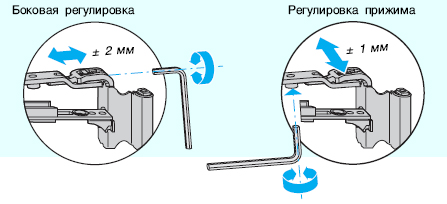
clamp
When assembling plastic windows, today it is customary to use two types of fittings, which differ in the principle of pressure adjustment. Roto Centro 100-101 fittings have adjustable strikers on the frame. In other types of fittings, the adjustment is made by turning the pins on the sash. You can do the work with an open-end wrench, "Asterisk" or the same hexagon, depending on the year of manufacture of the hardware and its manufacturer.
To strengthen the pressure of the sash against the frame, it is necessary to turn the pin so that the convex side turns towards the seal. As a rule, there is a marking in the form of a dash or a dot. In Roto Centro, the desired inclination of the keep is given (on the side where traces of contact with the sash pin are visible).
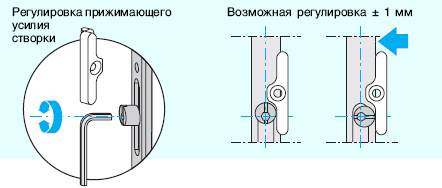
Adjusting the pressure of the plastic window sash
Also, a positive result can be obtained by increasing the pressure of the adjusting screw in the area of the lower and upper hinges.
That's all the recommendations on how to adjust a plastic window, I hope you use them and forget about drafts and ice.



